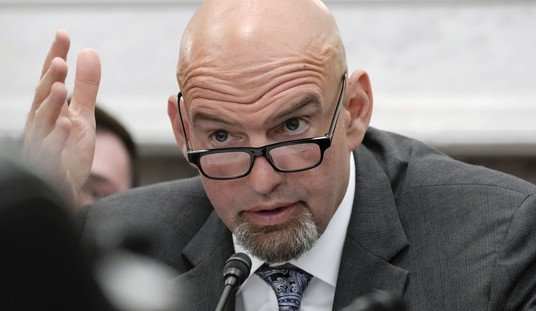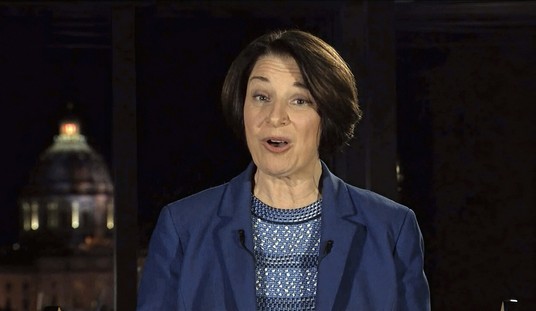Ten thousand a day, huh? And our reward for doing that isn’t even full normalcy but merely “degree” of it?
Confirmed: We’re never going back to normal.
You’re reading the headline and asking yourself, “Have we ever seen the seven-day average of cases drop below 10,000 per day?” We have not. Since March 25, 2020, when the daily average first crossed that threshold, never once have we crossed it from the other direction. For one brief shining moment, we got tantalizingly close:

On July 5, the day after Biden tempted fate by declaring independence from the virus, the seven-day average dipped below 11,000 for the first time, to 10,608. The next day it began climbing again and never looked back. We entered the age of Delta and since late July have never averaged less than *70,000 cases per day.* And cases at the moment are going up as the temperature drops, not down, as you might expect.
Fauci’s setting a benchmark here which he has every reason to believe we won’t reach for months. If ever.
“I think if we can get well below 10,000, I think that would be a level that I think would be acceptable to us to get back to a degree of normality,” Fauci said. “But again, I have to warn the listeners, these are not definitive statements — these are just estimates.”
Covid cases in the U.S. plateaued at between 70,000 and 75,000 per day for almost three weeks before starting to rise again toward the end of last week. Fauci said cases stabilizing at that high a level was a sign that the nation had “really bad control” over the pandemic, noting that the U.S. could be “in for some trouble” heading into the winter without taking proper public health precautions.
He actually left himself wiggle room there to declare that we shouldn’t get back to normal even if we do reach the 10,000-per-day mark. Maybe he’ll decide later that 5,000 per day is a better number.
Question: Why on earth is he still using cases to measure whether normalcy is in order or not instead of using hospitalizations or deaths? We have enough vaccines now to immunize everyone and boost them. We’ll soon have miracle therapeutics from Pfizer and Merck that should cut severe illness by something like 50 to 90 percent among the infected population. Once hospitals are no longer heavily burdened with COVID patients, who cares if there are 5,000 cases per day or 100,000? At that point COVID truly becomes the flu.
Let's be clear about the math here: 10,000 cases a day in the US would mean that just 1 in every 33,000 people was testing positive. And Fauci says we need to be below that number, even in places with high vax rates, to get to a "degree of normality"? Be serious.
— James Surowiecki (@JamesSurowiecki) November 17, 2021
Yesterday Fauci was asked whether the U.S. might see endemic COVID by … next year. “It’s conceivable that we will,” he said, promising nothing. I think many Americans are operating on the assumption that we’ve already reached endemic COVID, a state when the threat from the virus has stabilized and we simply learn to live with it. Most of those Americans trend right-wing but not all of them. Even David Leonhardt, one of the most influential columnists in big media, argued a few days ago that “Covid now presents the sort of risk to most vaccinated people that we unthinkingly accept in other parts of life. And there is not going to be a day when we wake up to headlines proclaiming that Covid is defeated… Eventually, the costs of organizing our lives around the virus will exceed the benefits. In some cases, we may have already reached that point”
Fauci hasn’t:
Dr. Anthony Fauci said it is possible for COVID-19 to be reduced to an endemic illness from the current health emergency next year if the U.S. ramps up vaccination rates. He called booster doses vital for that during the Reuters #TotalHealth conference https://t.co/NgLQlWKiJk pic.twitter.com/au0KPl8m7F
— Reuters (@Reuters) November 16, 2021
The goalposts have moved on vaccination too. Not only are we very far away from clearing the Faucian bar for endemicity, he’s now of the opinion that the booster shot should be regarded as part of the normal regimen of COVID immunization. It’s a three-dose vaccine, not a two-dose one. I don’t want to be churlish in complaining about that, as we’re all blessed to live in a country where our chief COVID problem is deciding whether to get a free extra shot of a life-saving medicine, but the idea of requiring three doses will feed the sense that normalcy is somehow getting farther away despite immunity continuing to build across the population.
I’ll give Fauci this, though. Some of the insistence lately that it’s time to return to full normalcy because endemic COVID has arrived feels desperate and smells of wishful thinking. That’s understandable, as we’ve all sagged under the weight of this misery for more than a year and a half. If now’s not the time for normalcy then when? But the numbers are what they are. Hospitalizations in the U.S. began to rise again over the past week. Cases are rising too, portending a new winter wave of greater or lesser magnitude. More than half of America’s states have less than 60 percent of their populations fully vaccinated. And there’s a major outbreak in parts of Europe that suggests rough times ahead here.
“We need to take all of this ideological, political nonsense out of the picture and realizing that the writing is on the wall. Take a look at what’s going on in Europe,” says Dr. Fauci, as a spike in European Covid raises concerns about another wave in the U.S. pic.twitter.com/viY68hrESx
— The News with Shepard Smith (@thenewsoncnbc) November 16, 2021
Some chunk of the country would look at all of that and say, “So what? Enough of this. It’s time to get back to normal.” I think that’s fair enough. But “I want to get back to normal” doesn’t mean we’ve reached endemic COVID. It seems possible after last winter’s ferocious wave that in two months’ time we’ll be pushing 200,000 cases a day again and 2,000 deaths or more. That’s not “endemic COVID.” But then the dynamic playing out here is a familiar one, no? Fauci is absurdly hypercautious in setting his benchmarks for normalcy and so much of the public reacts by countering with under-cautious ones. Me, I’m boosted, so I don’t much care anymore.








Join the conversation as a VIP Member